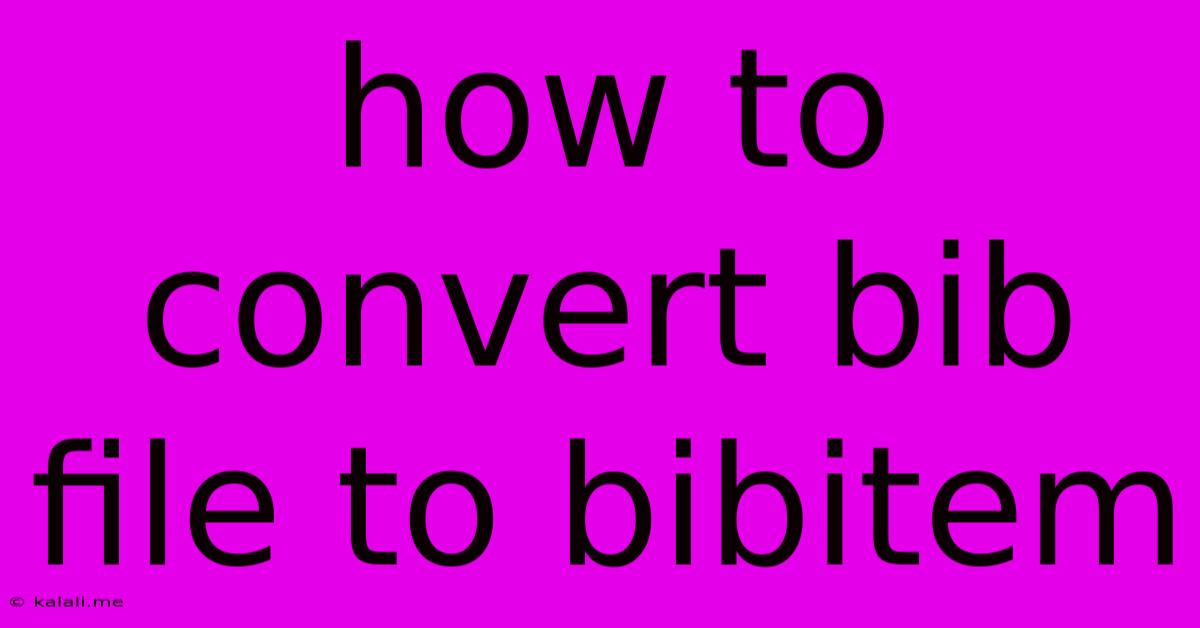How To Convert Bib File To Bibitem
Kalali
May 23, 2025 · 3 min read

Table of Contents
How to Convert a Bib File to Bibitem Entries: A Comprehensive Guide
This article will guide you through the process of converting a BibTeX (.bib) file into individual \bibitem entries suitable for inclusion in your LaTeX document. Understanding this process is crucial for properly citing your sources and generating a bibliography in your academic papers or publications. We'll cover several methods, from manual extraction to using scripting tools, ensuring you find the best approach for your needs.
What are BibTeX and Bibitems?
Before diving into the conversion process, let's clarify the terms. BibTeX is a bibliographic tool used with LaTeX to manage and format citations. A .bib file stores bibliographic data in a structured format. \bibitem entries are the LaTeX commands used to create individual entries in your bibliography. Essentially, you're converting structured data from a .bib file into the commands LaTeX understands to build your bibliography.
Method 1: Manual Extraction (For Small .bib Files)
This method is ideal for .bib files containing only a few entries. It involves manually copying and pasting relevant information.
-
Open your .bib file: Use any text editor to open your
.bibfile. -
Identify an entry: Each entry in a
.bibfile is enclosed in curly braces{}. -
Copy and paste the relevant fields: Each entry typically contains fields like
author,title,journal,year, etc. You will need to manually create the\bibitementry using these fields. For example, a.bibentry like:@article{article-minimal, author = {L. Author}, title = {A Minimal Article}, journal = {Journal of Minimal Articles}, year = {2023} }would translate into a
\bibitementry as:\bibitem{article-minimal} L. Author. A Minimal Article. *Journal of Minimal Articles*, 2023. -
Repeat for all entries: Repeat steps 2 and 3 for each entry in your
.bibfile. Remember to adjust the formatting to match your bibliography style.
Method 2: Using a Script (For Larger .bib Files)
For larger .bib files, manual extraction becomes tedious and error-prone. Using a script (e.g., a Python script) provides a more efficient solution. While providing a complete script here would exceed the scope of this article, the basic principle involves parsing the .bib file and generating the \bibitem entries programmatically. This approach allows for automation and customization, handling a large number of entries quickly and accurately. Searching online for "Python BibTeX to Bibitem" will yield various scripts readily available for adaptation.
Method 3: Utilizing Biblatex (The Recommended Approach)
The most efficient and recommended method is using the biblatex package in LaTeX. biblatex is a powerful package that handles the entire bibliography management process, including the creation of \bibitem entries from your .bib file. This eliminates the manual conversion entirely. Simply include the biblatex package in your LaTeX preamble and use the \cite command to cite entries from your .bib file. biblatex will automatically generate the bibliography.
Example using biblatex:
\documentclass{article}
\usepackage[backend=biber,style=alphabetic]{biblatex}
\addbibresource{mybibliography.bib} % Replace with your .bib file name
\begin{document}
This is some text. \cite{article-minimal}
\printbibliography
\end{document}
Remember to run biber (a backend program for biblatex) before compiling your LaTeX document.
Conclusion:
Converting a .bib file to individual \bibitem entries is unnecessary in most cases. Using biblatex offers the most straightforward and efficient solution for managing your bibliography in LaTeX. However, understanding manual conversion and scripting methods provides valuable insight into the structure of BibTeX files and LaTeX commands. Choose the method that best suits your needs and technical skills. Remember to always double-check your citations for accuracy.
Latest Posts
Latest Posts
-
What Is 1 4 Of 1 4 Cup
Jul 02, 2025
-
Is Keri Russell Related To Kurt Russell
Jul 02, 2025
-
What Is Half Of 1 4 Teaspoon
Jul 02, 2025
-
How Many Cups In A Pound Of Hamburger Meat
Jul 02, 2025
-
Imagery Or Figurative Language From Romeo And Juliet
Jul 02, 2025
Related Post
Thank you for visiting our website which covers about How To Convert Bib File To Bibitem . We hope the information provided has been useful to you. Feel free to contact us if you have any questions or need further assistance. See you next time and don't miss to bookmark.